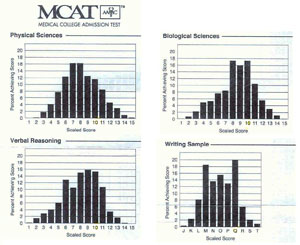Physics 029
Physics for the Biological Sciences
A Brief Comment Regarding MCAT
The University of Western Ontario does not provide MCAT preparation courses. However, we know that a notable fraction of our students plan to take this or similar admission tests, and we want them to succeed in pursuing their career choices.

Click on image for full size version (opens in new window).
The graph you see is the performance statistics for all students who wrote the MCAT in the academic year 2005/2006. It shows the distribution of scores for the four parts of this test. If you compare the Biological Sciences and the Physical Sciences you notice that scores in Physical Sciences tend to be lower. This has two reasons: (I) Traditional textbooks in Physics and General Chemistry do not cover all material required on the MCAT test (there is a grey–zone gap), leaving the student ill–prepared for major sections. (II) Traditional physics textbooks and courses do not identify the relevance of physics in Medicine, Dentistry and related Health Sciences, leaving the student with a huge unstructured body of information with no connection to their overall preparation.
The textbook used in P028/P029 has been developed with the MCAT subject list in mind. It is written such that it points for each concept to its relevance in the Life Sciences, and thus connects to the student’s preparation in Biology, Chemistry and other medical and health science disciplines.